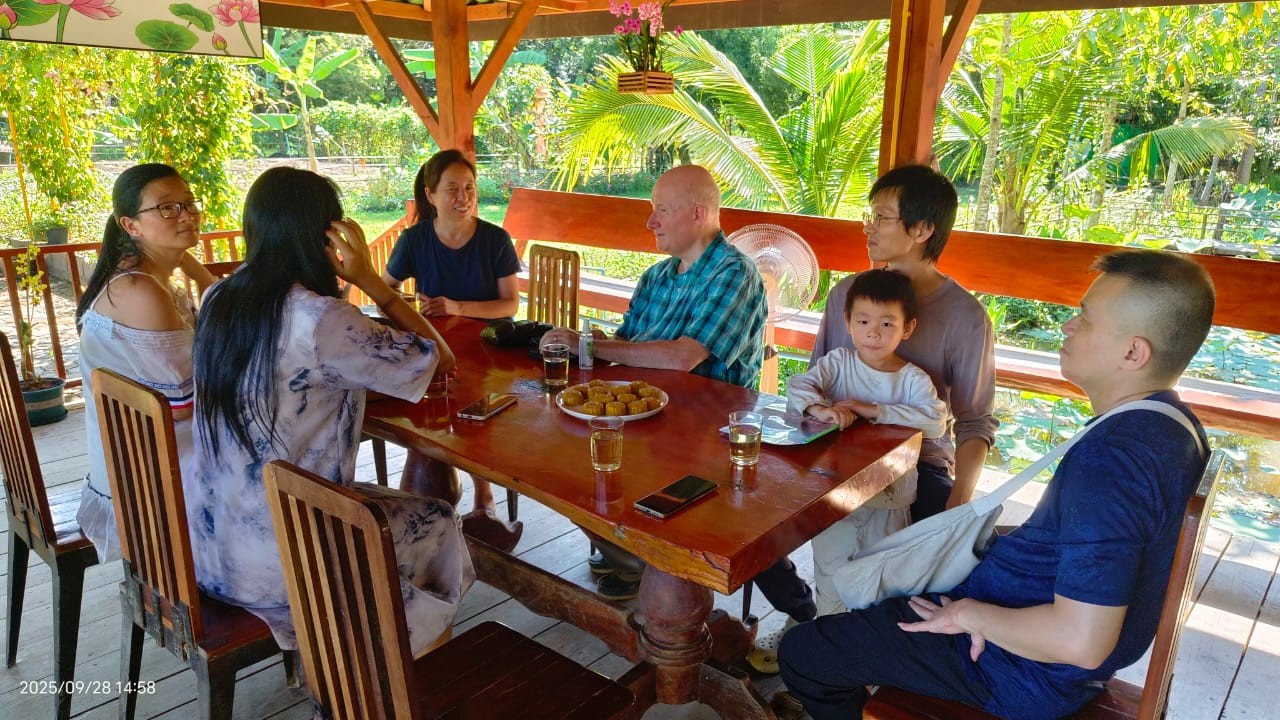|
《寒冬》编辑 Massimo 刊登第一篇: 走进生命禅院:在迫害阴影下的光明社区
戒镜草
亲爱的导游叔叔和各位亲人们好,
在佛祖上帝的恩典下,在道的巧妙安排中,我怀着感恩的心,感谢生命禅院泰国分院所有亲人的优秀仙性绽放,带来温暖与光明。
同时,我感谢《寒冬》编辑Massimo的来访,他将陆续发布六篇关于生命禅院与第二家园的真实体验。昨天,我们迎来了第一篇——“Inside Lifechanyuan: A Community of Light in the Shadows of Persecution”,让我们一同感受这段光明心灵旅程的美好与宁静,感受这位学者笔下的我们。
Inside Lifechanyuan. 1. A Community of Light in the Shadows of Persecution
10/13/2025 Massimo Introvigne
I was the first scholar to visit the “Second Home” in Thailand of a unique spiritual family that combines Buddhism, esoteric traditions, and religion-based “communism.”
by Massimo Introvigne
Article 1 of 6.
Massimo Introvigne with members of Lifechanyuan at the Thai Second Home, September 2025.
In April 2021, one of the brave citizen journalists risking imprisonment for sending news from China to “Bitter Winter” alerted us to a little-known but dramatic event unfolding in China’s Guizhou province. He shared documents, photographs, and police reports about a group few outside China had heard of: Lifechanyuan, also known as the Life Zen Temple (生命禅院).
What we uncovered was chilling. On April 28, 2021, starting at 1 a.m., Public Security forces and agents from the anti–xie jiao unit—responsible for cracking down on so-called “heterodox teachings”—raided two remote communal settlements in Tongzi and Anlong counties. By dawn, they had taken control of the sites, where around one hundred people from thirteen provinces lived peacefully. Authorities called the operation a textbook “cult” crackdown. Members were detained, told their movement was banned, and taken away for “deprogramming.”
According to official reports, many resisted—not with violence, but with tears and cries of defiance. “We would rather die than leave,” some shouted. Yet within three months, most had been “reeducated” and placed under the supervision of relatives. Authorities claimed this was only the beginning: Lifechanyuan had over 2,000 members, many still in hiding, and their leader lived safely in Canada. The hunt continued.
Our article in “Bitter Winter” brought this story to light. It was later read and appreciated by Lifechanyuan members, who thanked us with gratitude and further testimony. Then, on July 3, 2025, a second wave of repression struck. Coordinated by China’s Ministry of Public Security, the crackdown detained eighty-two members across multiple provinces. Homes were raided, devices seized, and individuals coerced into signing ideological denunciations of their beliefs. A second article followed, along with encrypted correspondence with a member named Jiejing.
Through Jiejing, I was invited to visit the “Second Home” of Lifechanyuan—a community of exiled members who had relocated to the borderlands between Thailand and Myanmar. In September, I accepted.
After this recent visit to the community in Thailand, I feel compelled to set aside the scholar’s pen and speak from the heart. I had studied their community from afar—poring over websites, reading poignant testimonies of unjust persecution, and exchanging emails with Sister Jiejing. Yet no amount of reading or remote dialogue could prepare me for the quiet revelations that come only through immersion.
There is a principle in social scholarship called participant observation. It suggests that to truly understand a community, one must live its rhythms, even briefly. So, I did. During those few days, I did not just observe—I shared meals, laughter, silence, and the subtle grace of their daily lives. What I experienced was not only a worldview but a living testament to it: a community that embraces simplicity as liberation, faces challenges with joy, and finds fulfillment through connection.
The author at the Tai Second Home.
Every person I encountered had a story—some marked by hardship, others by quiet resilience—but all converged in a shared pursuit of happiness and spiritual clarity. Their peaceful community is a bright counterpoint in a world that often equates success with material wealth and status. Perhaps few will choose the path they walk, but even those of us who do not must look at them as a mirror and a reminder.
Lifechanyuan is hard to categorize. It is a spiritual movement, a communal experiment, and a metaphysical school. Founded by Guide Xuefeng, a charismatic thinker and mystic, it draws from Taoism, Buddhism, Christianity, the Communist tradition, and science—but reinterprets them through a unique cosmology. Members call themselves “Celestials.” Their teachings focus on harmony with nature, simple living, and spiritual growth.
Their theology is expansive. It begins with Wuji—the primordial non-state of chaos and potential—and traces the emergence of Taiji, the birth of the Greatest Creator, and the formation of gods, angels, and humans. Their cosmology, which I will explore in a subsequent article, offers a sweeping narrative of the universe’s origin and humanity’s spiritual diversity.
But Lifechanyuan is not just a belief system. It is a way of life. Members live communally, share resources, and cultivate joy through service and community work. They reject materialism, hierarchy, and violence. Their homes—whether in China, where they have all been raided and closed by the police, or exile—are called “Second Homes,” reflecting their belief that true belonging lies in spiritual kinship, not geography.

Sharing mooncakes with Celestials.
In China, Lifechanyuan has been labeled a xie jiao—a “heterodox teaching—a designation that carries severe legal consequences. The term is often used to suppress spiritual movements outside state-sanctioned frameworks. Lifechanyuan’s communal lifestyle and metaphysical teaching have made it a target.
Yet unlike other groups branded as “cults,” Lifechanyuan has never been accused of violence, coercion, or criminal activity. Its members are peaceful, articulate, and deeply committed to ethical living. The persecution they face is not a response to danger but a reaction to difference.
This article is the first in a series exploring Lifechanyuan’s history, theology, cosmology, and communal life. In the coming pieces, I will delve into their metaphysical framework, their reinterpretation of religious texts, and their vision for humanity’s spiritual future.
Whether you are a scholar, a seeker, or simply curious, I invite you to explore the heart of this extraordinary community. In a world divided by ideology and fear, Lifechanyuan presents a quiet yet radical idea: that peace, purpose, and joy are, in fact, human rights.
中文翻译:
走进生命禅院 1:在迫害阴影下的光明社区
我是首位踏入生命禅院第二家园泰国分院的学者,这里汇聚了一个独特的精神群体,他们将佛教的智慧、密宗的奥秘与宗教化的“共产主义”理想融汇于一体。
第1篇(共6篇)
——Massimo Introvigne
2021年4月,一位勇敢的公民记者冒着入狱的危险,将中国的消息送往《寒冬》,提醒我们关注贵州省正在悄然发生的一件鲜为人知却意义深远的事件。他提供了文件、照片与警方报告,讲述了一个在中国境外几乎无人知晓的群体:生命禅院(Lifechanyuan),亦称生命禅寺(The Life Zen Temple)。
我们揭示的事实令人心惊。2021年4月28日凌晨一点,公安部门及负责打击“邪教”的专案组悄然突袭了桐梓县和安龙县的两个偏远社区。天亮时,警方已完全掌控了这些社区——约百名成员,来自十三个省份,原本平静和睦地生活在一起。官方将此次行动称为“邪教”打击的典型案例。成员们被拘留,被告知组织已被取缔,并被带走接受所谓的“洗脑教育”。
根据官方报告,许多人没有以暴力反抗,而是用泪水与呼喊表达抗议。“宁愿死,也不愿离开,”有人声声喊道。然而,仅在三个月内,大部分成员被迫接受“再教育”,并交由亲属监管。官方称,这只是开始:生命禅院共有两千余名成员,其中许多人仍在隐匿,而领袖则安然居于加拿大。追捕的阴影仍在延伸。
我们在《寒冬》上刊登的文章揭示了这一事件。随后,生命禅院的成员阅读后表示感激,并提供了更多见证。2025年7月3日,第二波打压悄然展开,由中国公安部协调,多省八十二名成员被拘留。住宅被搜查,设备被没收,个人被迫签署对自身信仰的思想批判书。随后,我们发表了第二篇文章,并通过加密通信与一位名叫戒镜的成员取得联系。
通过与戒镜的联系,我受邀踏入生命禅院的第二家园——一个由流亡成员组成的社区,他们远离故土,安居于泰国与缅甸交界的边境之地。九月,我应邀前往,亲身探访这片宁静而坚韧的精神家园。
在我最近踏入生命禅院第二家园泰国分院之际,我心中油然而生一种冲动——暂放学者之笔,以心声表达所感。我曾从远方凝望他们的社区——细读他们的网站,倾听那些勇敢的公民记者为安全隐匿姓名而寄来的令人心碎的见证,记录着他们在中国遭受不公迫害的真实故事。我也曾与戒镜通信。然而,无论阅读多少文字,进行多少远程交流,都无法让我预见,那种唯有身临其境才能触及的宁静启示与心灵震撼。
在社会学里,有一个原则叫“参与式观察”。它告诉我们,若想真正理解一个群体,就必须亲身融入他们的生活节奏,哪怕只是短暂的时光。于是我这样做了。在那几日里,我不仅仅是观察者——我与他们共享餐食,笑声与静默,感受他们日常中那一份含蓄而细腻的优雅。我所遇见的,不只是一个世界观,而是它鲜活的体现:一个以简朴解放心灵的社区;一个以喜悦迎接挑战的社区;一个在彼此相连中寻得圆满的社区。
我遇见的每一个人都有自己的故事——有的刻满艰难与磨砺,有的流露宁静而坚定的韧性——然而,所有的故事都汇聚到同一个追寻:一种内心澄明、灵魂清澈的幸福。在这个常将成功等同于物质财富与社会地位的世界里,他们宁静的社区如一道明亮而温暖的光,映照着另一种生活的可能。或许,走上t他们道路的人寥寥,但即便是我们这些未曾选择的人,也必须向他们凝望——既作为镜子,也作为提醒。
生命禅院难以被简单归类。它既是一场精神运动,也是一场社区实验,更是一所形而上学的学派。由充满魅力的思想家与神秘导游雪峰创立,它汲取道教、佛教、基督教、共产主义传统以及科学的智慧,却通过独特的宇宙观予以重新诠释。成员自称“禅院草”,其教义强调与自然和谐共处、简朴生活,以及精神的成长与升华。
其神学体系恢宏而深邃。它始于“无极”——原始的混沌与潜能之境——继而追溯“太极”的生成、“至高造物主”的诞生,以及神灵、天使与人类的形成。他们的宇宙观将在后续文章中进一步阐释,呈现一幅关于宇宙起源与人类精神多样性的壮丽画卷。
然而,生命禅院不仅仅是一套信仰体系,更是一种生活的艺术。成员们共同生活、共享资源,通过服务与社区工作在平凡中培养喜悦。他们拒绝物质主义、等级制度与暴力。无论是在中国——那些曾被警方查封和关闭的住所——还是在流亡地,他们的家园都被称为“第二家园”,彰显出他们的信念:真正的归属,源自精神的亲缘,而非地理的界限。
在中国,生命禅院被贴上了“邪教”的标签——一个带来严厉法律后果的定义。这个称谓常被用来压制那些不在国家认可框架内的精神运动。生命禅院的社区生活方式与深邃的形而上学教义,使它成为了压制的焦点。
然而,与其他被贴上“邪教”标签的团体不同,生命禅院从未被指控过暴力、胁迫或犯罪。其成员和平而善于表达,内心深切致力于道德与善行。他们所承受的迫害,并非源于危险,而是因其不同而生。
本文是关于生命禅院历史、神学、宇宙观与社区生活的系列报道的首篇。在接下来的文章中,我将进一步探索他们深邃的形而上学框架、对宗教经典的独特诠释,以及他们对人类精神未来的远景与愿景。
无论你是学者、探索者,还是仅仅怀着好奇,我都邀请你走进这个非凡社区的心灵深处。在一个被意识形态与恐惧分裂的世界里,生命禅院静默而坚定地提出一个激进的理念:和平、意义与喜悦,本应是每个人与生俱来的权利。
|